|
Other 90* ells with turning vanes
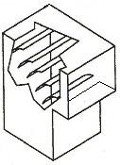
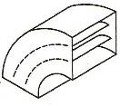
Organizations governing Hvac and Duct Design
ACCA
ASHRAE
SMACNA


|

HVAC for BEGINNERS: DUCTWORK BASICS
Rectangular Ells, Tees, and Reducers
Here in our Hvac for Beginners duct fittings section we will look at some common duct fittings and configurations. On a previous page we discussed plenums and return air drops. On this page we will look at common hvac system ells, tees, and reducers.
As discussed in our Hvac for Beginners main page, each component of a forced air system, from the filter to each branch duct, adds a certain amount of restriction to the airflow of that system. Every duct fitting adds a certain amount of restriction. This restriction (friction loss) adds to the TEL (total equivalent duct length) of the system.
Therefore, the TEL of the ducting must be minimized for the best performing comfort system.
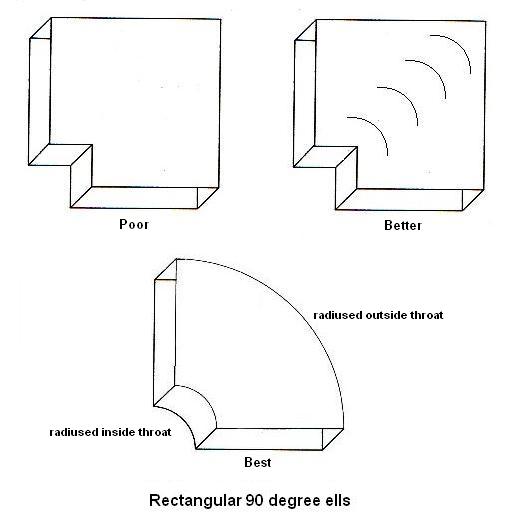
- 90 degree turns in forced air ducting are to be avoided whenever possible. However, if structurally there is no choice, there are ways to minimize impact.
- Example 1, the square ell is very poor for airflow. This fitting will add 80' to the TEL. And where you find one, you usually will find two square ells.
- The square ell can be improved substantially with the addition of interior turning vanes. These can be fabricated at any sheet metal shop.
- If your duct system requires 90 degree ells, insist that both inside and outside throats be radiused. This fitting will add 25' to the TEL. Add turning vanes to this ell and impact to the TEL is only about 10'.
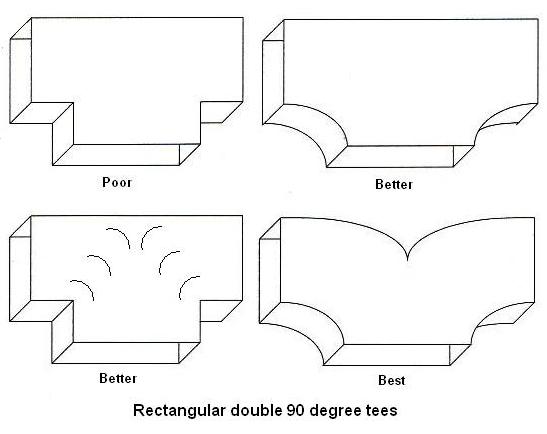
- A tee is usually utilized in a duct system when the main trunks must be located in the hallway, and the AH/furnace must be located remotely in a mechanical room or closet.
- A plenum ell is usually used in conjunction with a tee. Proper sizing of the trunkline between the two will make or break the performance of your comfort system.
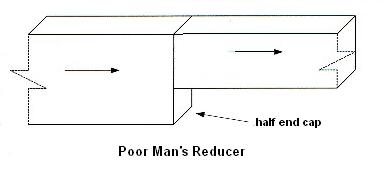
It is amazing how often this type of reducer can be seen installed in comfort systems. If you see your mechanical contractor using this reduction method, especially in the supply trunk, insist that he replace it with a better reducer (pictured below). This fitting can be equal to 80' added to the TEL.
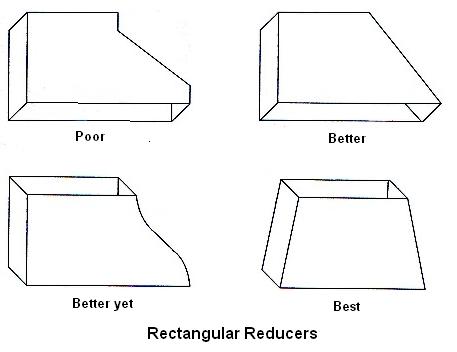
- A reducer is usually placed in the supply trunk after 3 or 4 branches have been tied in. This helps to equalize the duct pressures and balance the airflow.
- As you can see, example 1 is quite sharp on the reducing side. This can be minimized by making the reducer longer.
- Reducers are not the enemy. Quite the contrary. Proper placement of a well engineered reducer can help the system performance.
Other Ductwork Related Pages
Residential Hvac Duct Drawings
by Geoffrey R. Stoddard, Hvac Designer / Detroit, Mich.
Hvac for Beginners: The Typical Trunk and Branch Duct System
Good Ducting Practices: Plenums and Return Air Drops
More Ductwork Transitions: Rectangular Side Take-offs and Vertical Ells
Multiple Duct Fittings in a Duct System
Basic How-To Ductwork Installation
Return to Hvac Ducting main page
Leave Duct Fittings and Return to HOME

Please feel free to link to this page from your website. This page's URL is: http://www.perfect-home-hvac-design.com/duct-fittings.html
Enjoy this page? Please pay it forward. Here's how...
Would you prefer to share this page with others by linking to it?
- Click on the HTML link code below.
- Copy and paste it, adding a note of your own, into your blog, a Web page, forums, a blog comment,
your Facebook account, or anywhere that someone would find this page valuable.